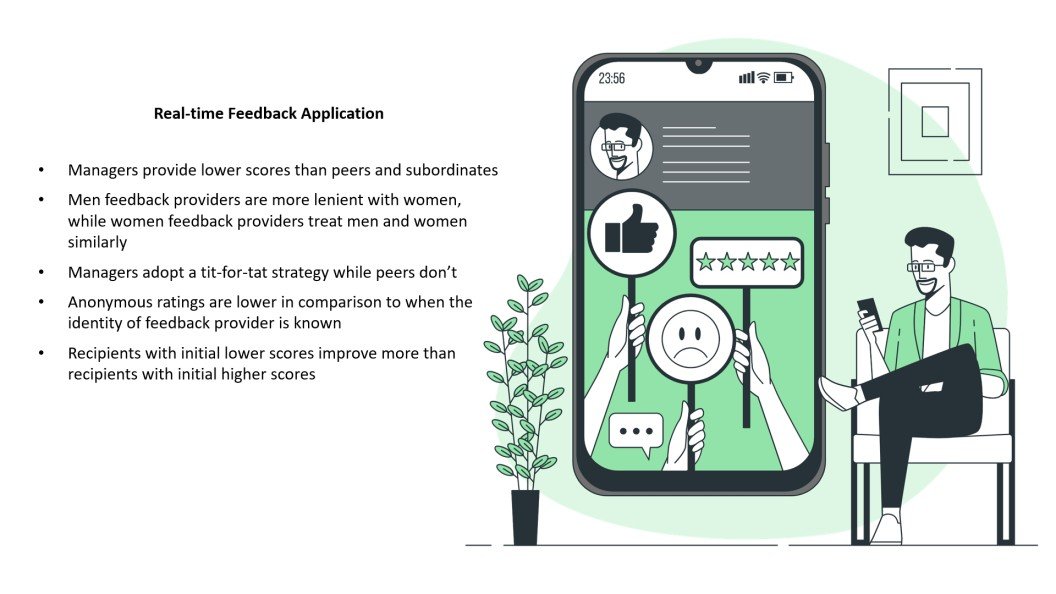Digest 35. Real-time feedback apps: A way to reach frequent, timely, meaningful, & event-based feedback
A consolidated trend over the past 5+ years has been for many large organizations to greatly rethink, if not dropping altogether, its appraisal system. As Buckingham and Goodall reported in an HBR article already in 2015, Deloitte had abandoned its rating system, and many others, such as Accenture and GAP did the same. The reason was that traditional annual performance reviews did not seem adequate for accompanying the fast pace of business and ensuring individual performance improvement. So, this is no news. What is new, though, is that organizations are now turning to online applications for providing real-time feedback. The advantage of these apps is that they enable timely, frequent and – most important – what we call event-focused feedback (Dello Russo and Miraglia, 2021, EAWOP).
Real-time feedback applications are different from traditional performance management systems (including not only the old-fashioned paper-and-pen systems but also other online, non-application-based systems) in that they are embedded in a mobile device like a phone, which facilitates frequent, timely, ongoing use, and even forms habits in the phone owners. Moreover, it allows for constant updates and information, which could motivate feedback recipient to even adjust their performance in real time.
What are the effects of real-time feedback application on employee performance appraisals?
In this regard, Rivera, Qiu, Kumar, and Petrucci (2021) conducted a study using a real-time feedback application called DevelapMe which was used in five organizations from pharmaceutical, healthcare, interior design, and payment processing industries. The data comprised around 5000 instances of feedback from the application which were collected between February and June 2017 in four organizations and between September and November 2017 in the fifth organization.
The unit of analysis was the instance of feedback which is the behavior on which one employee rates another employee at a given time. A total of 1019 feedback instances were provided anonymously, while 3956 were given with the full name of the feedback provider. Of those non-anonymous feedback, 806 were provided by subordinates (20%), 2224 by peers (56%), and 926 by managers (24%). In this sample, 115 employees received feedback and 111 employees provided feedback. On average, an employee received 43 and provided 45 instances of feedback.
Rivera and colleagues found that, in the context of real-time feedback application, the ratings employees receive from their managers are lower than the ratings they receive from their peers and subordinates showing that managers are more critical.
Moreover, in real-time feedback, men feedback providers rate women more leniently than men. Women feedback providers, on the other hand, tend to rate women and men similarly, which is also similar to the way men feedback providers rate men feedback recipients. These gender differences could have several explanations. They may reveal, for example, the “positive” sexism of men feedback providers, but it could also happen that it is strategically done: because women are more cooperative and reciprocating in comparison to men, men may rate women higher in the hope of their reciprocation in the future. Moreover, we should not overlook that men’s feedback to women tends to be more positive but more vague, while men’s feedback to men is more critical but more specific which is an important element for development (for more gender-based feedback check out Digest 34).
The results also showed that managers tend to adopt a tit-for-tat strategy while peers do not follow this strategy. Tit-for-tat strategy consists in cooperating in round one and then mimicking the behavior held in round one by the other party in the next round. In the real-time feedback context, this strategy is manifested when an employee gives a higher rating to another employee who rated her high in the previous round and vice versa: a further lower rating to those that originally rated them low. One explanation for managers’ greater use of the tit-for-tat is that they usually have more bargaining power than peers and such strategy would enable them to act harshly to sanction or prevent any deviation from the “cooperative” equilibrium.
In real-time feedback applications, employees tend to rate lower when they are anonymous, and higher when their identity is known. For this reason, anonymous ratings are considered to be less biased.
Rivera and colleagues also found that the scores of recipients who had received low scores initially increase more significantly in comparison to those who had received higher scores initially. This is while traditionally negative feedback was seen as demotivating and influencing future performance negatively. This difference could be due to the fact that real-time feedback is event-based and ensure issues are addressed in a timely manner. It may also be due to the fact that event-based feedback is more specific and helps improve a behavior rather than being perceived as a judgment on the person as a whole (see Digest 3 for more details on the features of high-quality feedback).
Organizational implications
Organizations can be encouraged in the use of application-based performance management systems for the following reasons:
Real-time feedback is more accurate and less biased by previous scores as they are event-based and more task-focused.
Instant and continuous feedback provides more information and a clearer picture of employees’ strengths, weaknesses, and performance.
Real-time feedback helps recipients with initial low scores to increase their scores significantly over time.
Real-time feedback motivates and helps employees to perform well every day of the year, not just when the annual evaluation is approaching.
——
Reference: Rivera, M., Qiu, L., Kumar, S., & Petrucci, T. (2021). Are traditional performance reviews outdated? An empirical analysis on continuous, real-time feedback in the workplace. Information Systems Research, 32(2), 517–540. https://doi.org/10.1287/isre.2020.0979

